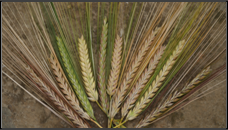Wolfgang Friedt
Coming of age on molecular breeding
Department of Plant Breeding, IFZ, Justus Liebig University Giessen, Heinrich-Buff-Ring 26-32, D-35392 Giessen
The productivity of major agricultural crop plants has been significantly enhanced by breeding during the last decades. Particularly strong yield increases in leading crops such as maize (corn), wheat and oilseed rape (OSR) have lead to the continuous extension of cultivating such crops in moderate climates e.g. in northern Europe. Simultaneously, other adapted crops tend to lose importance; such examples are oats, potatoes, beets and various fodder plants like alfalfa, clover and forage grasses. The invention of biotechnology tools, such as cell and tissue culture and molecular techniques, and their application has enhanced the breeding progress particularly in major crops. Correspondingly, the gap between major and minor crop plants continues to grow. In recent years, extensive genomic information has been collected and sequence data are being made available for breeding of important crop plants, e.g. indirect marker-assisted selection (MAS) particularly focusing on mono- and oligogenic input characteristics (e.g. resistance) and output traits (e.g. product quality). In addition, molecular markers serve as valuable tools for i) discriminating germplasm and genetic pools, ii) identification of female (male sterile, maintainers) and male lines (restorers) in hybrid breeding, and iii) determining purity after hybrid seed production. Continuous selection for superior quality of major cash crops such as OSR has narrowed genetic diversity during the last decades. However, the application of biotechnology and molecular tools allow the transfer of genomic segments or quantitative trait loci (QTL) and genes from related species or even genera into adapted breeding stocks to broaden the genetic composition and create novel genotypes with improved attributes. Such an example is the genetic dissection of quantitative resistance of rapeseed against Verticillium disease by QTL analysis and its implementation in OSR breeding. Based on such material, underlying resistance genes can be identified by map-based cloning or by functional analysis using differential expression studies or candidate gene information. An example of such an approach is the genetic analysis of non-specific resistance of bread wheat against Fusarium root rot and head blight causing significant yield loss and mycotoxin contamination of the wheat grains, meal and flour. A major breeding aim today and in the future is the improvement of biomass and market yield. Since high-yielding crops tend to be susceptible to abiotic or biotic stress, resistance against such stresses is basically important to stabilize and sustain crop yield and production. Nevertheless, for future needs the yield potential of major food plants has to be significantly enhanced. Research activities in wheat and oilseed rape illustrate current approaches using molecular tools. For example, genome-wide association (GWA) analysis allows the identification of virtually all genomic regions significantly involved in the control of quantitative traits. Novel approaches of phenotyping using physical principles and devices allow an objective and more precise characterization of quantitative crop attributes. Emphasis of developing molecular markers and their implementation in breeding is laid on i) joining conflictive goals such as disease or pest resistance with outstanding seed yield and quality, and ii) increasing yield by advancing the exploitation of heterosis for raising the yield potential. In the future, novel approaches may be used to benefit from genetic phenomena such as recombination and polyploidy; this may allow to broaden genetic diversity and useful variation in breeding populations – even of minor or underutilized crops - and to elevate the biomass yield potential and competitiveness of crop plants.




